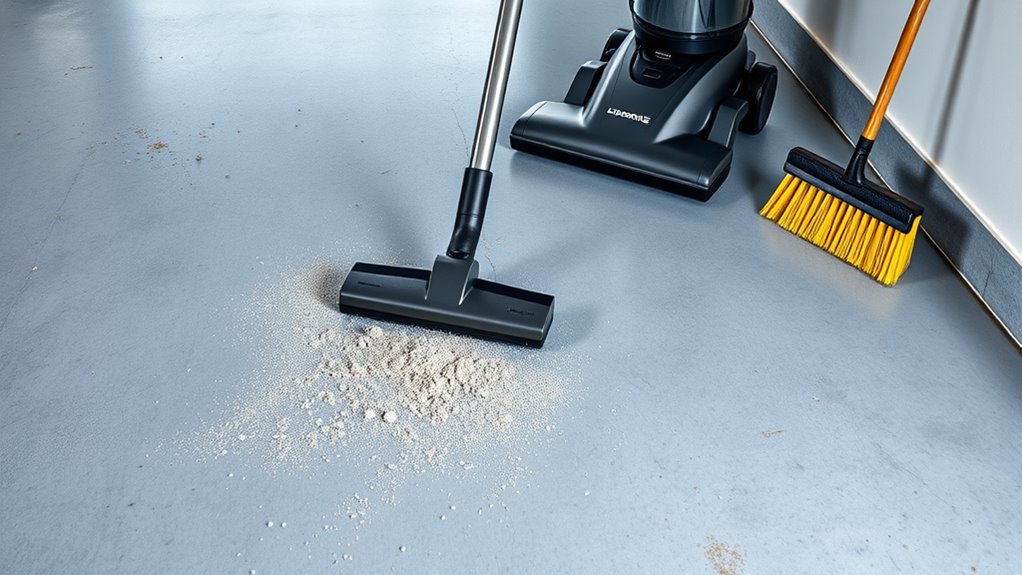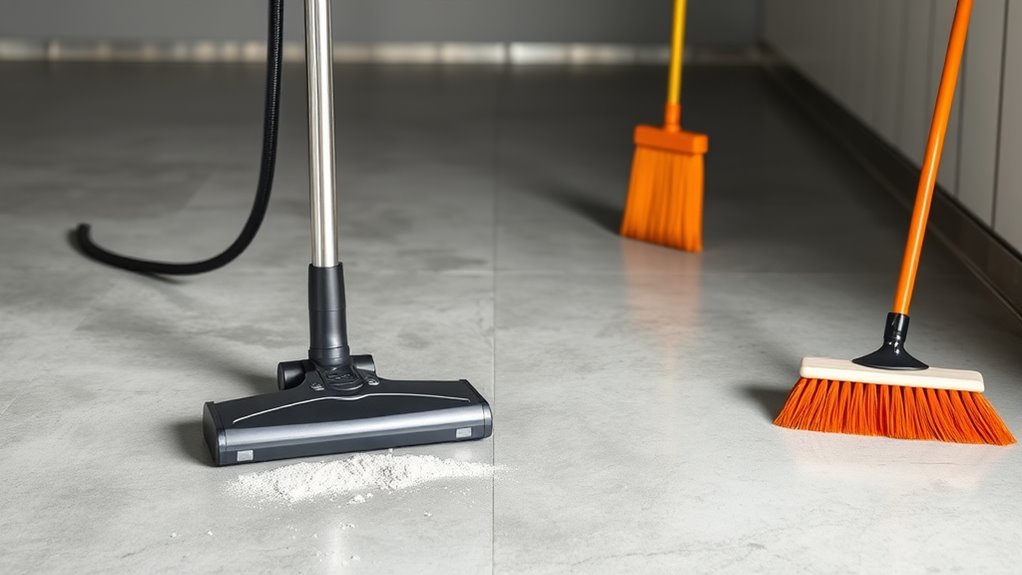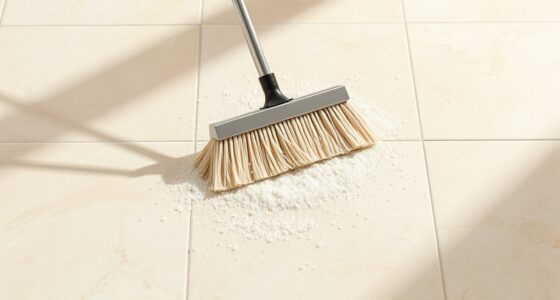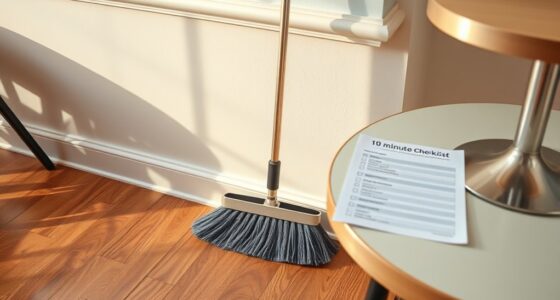For garage floors, sweeping is a quick, cost-effective way to pick up loose dust, dirt, and leaves, especially on rough surfaces, and it’s easy to do daily. If you want a deeper clean, especially for fine dust, pet hair, or heavy debris, vacuuming works better and reduces airborne dust. Combining both methods can give you the best results. To learn which approach suits your garage best, keep exploring your options.
Key Takeaways
- Sweeping is quick and cost-effective for daily removal of loose debris and dust.
- Vacuuming provides a deeper, more thorough clean, especially for fine dust, pet hair, and heavy debris.
- Use sweeping for rough, uneven surfaces and hard-to-reach corners; vacuum for detailed, fine cleaning.
- Combine both methods for optimal cleanliness and safety, especially in heavily used or dusty garages.
- Consider your budget, cleaning frequency, and specific garage needs to choose the most suitable tool.

Keeping your garage floor clean is vital for safety and maintenance, and choosing between sweeping or vacuuming can make a difference. When it comes to garage floor maintenance, selecting the right cleaning equipment is essential to keep the space safe, tidy, and in good condition. Both sweeping and vacuuming have their advantages, but understanding their differences helps you make an informed choice based on your specific needs.
If you’re considering a simple, cost-effective method, sweeping might be your best option. It’s straightforward, requires minimal equipment—just a sturdy broom—and works well for removing loose debris like dust, dirt, leaves, and small particles. Sweeping is especially effective on rough or uneven concrete surfaces because you can reach into crevices and corners easily. Plus, it’s quick for daily maintenance, helping you keep the garage tidy without much hassle. However, sweeping has limitations when it comes to fine dust or small particles that can settle deep into the surface or get airborne, potentially creating a mess or health concern if not properly managed.
On the other hand, vacuuming offers a more thorough approach to garage floor maintenance. Modern shop vacuums or wet/dry vacuums are designed to handle larger debris and fine dust particles, making them highly effective for deep cleaning. They can pick up everything from sawdust and pet hair to small dirt particles that sweeping might miss. Vacuuming also reduces airborne dust, which is better for your health, especially if you have allergies or respiratory issues. The downside is that vacuums generally cost more and may require more effort to operate, especially if you’re dealing with larger debris or wet spills. They also need regular maintenance, like emptying the canister or replacing filters. Additionally, incorporating proper ventilation can help mitigate dust clouds created during cleaning.
When comparing the two, think about the cleaning frequency and the level of cleanliness you desire. For regular quick cleanups, sweeping is often sufficient and quicker. If your garage sees heavy use—like woodworking, gardening, or vehicle maintenance—you might benefit from vacuuming to ensure a more comprehensive clean. A cleaning equipment comparison shows that vacuums tend to be more effective at removing fine dust and small particles, though they may not always reach into tight corners as easily as a broom. Conversely, sweeping is more accessible and requires less setup, making it ideal for quick, everyday maintenance.
Ultimately, your choice depends on your garage’s specific needs and your personal preference. You might find that a combination of both methods works best: sweep regularly for quick cleanups and vacuum periodically for a deep, thorough clean. This approach ensures your garage stays safe, clean, and well-maintained without spending too much time or money on equipment.
Frequently Asked Questions
Can I Use a Household Vacuum on Garage Floors?
You can use a household vacuum on your garage floor, but it might not be the best choice. Most household vacuums aren’t designed to handle the dirt, debris, and moisture often found on garage floors. They may clog or wear out quickly. For a more effective clean, consider a wet/dry vacuum or a broom, which are better suited for the messes typically found on garage floors.
How Often Should I Sweep or Vacuum My Garage?
An ounce of prevention is worth a pound of cure, so you should sweep or vacuum your garage at least once a week. This frequency helps manage dust accumulation rates and keeps your space tidy. If you notice more dirt or debris, increase cleaning to twice a week. Regular maintenance prevents buildup and makes deeper cleaning easier, ensuring your garage stays clean and safe for projects or storage.
Are There Specific Vacuums Designed for Garage Floors?
Yes, there are specialized vacuums designed for garage floor cleaning. These models often feature strong suction, wide nozzles, and durable filters to handle dirt, debris, and even small stones. Using a specialized vacuum makes garage floor cleaning more efficient and helps prevent damage to regular vacuums. Look for industrial or shop vacuums with heavy-duty construction, as they’re built specifically to tackle the dirt and messes common in garage environments.
What’s the Best Way to Remove Oil Stains From Garage Floors?
To remove oil stains from your garage floor, start by applying a degreasing agent or a mixture of dish soap and warm water. Scrub the stain with a stiff-bristled brush, then let it sit for 15-20 minutes. Rinse thoroughly with water and use a wet/dry vacuum or mop to remove excess moisture. Regular garage floor cleaning helps prevent stubborn stains and keeps your space looking fresh.
Should I Sweep Before or After Vacuuming the Garage?
Sweeping your garage is like dusting off a canvas before painting—start with a clear surface. You should sweep before vacuuming during garage cleaning because sweeping loosens dust and debris, making vacuuming more effective. Comparing tools, sweeping handles larger debris, while vacuuming picks up fine particles. This method guarantees a thorough clean, keeping your garage spotless and well-maintained. Always sweep first for best results.
Conclusion
Choosing between sweeping and vacuuming your garage is like selecting the right brush for a masterpiece. Whether you clear debris with a broom or lift dust with a vacuum, you’re nurturing a clean slate for new beginnings. Think of your garage as a garden—regular care keeps it thriving. So, pick your tool, roll up your sleeves, and turn your garage into a sanctuary where clutter and dust fade away, making space for fresh possibilities.









